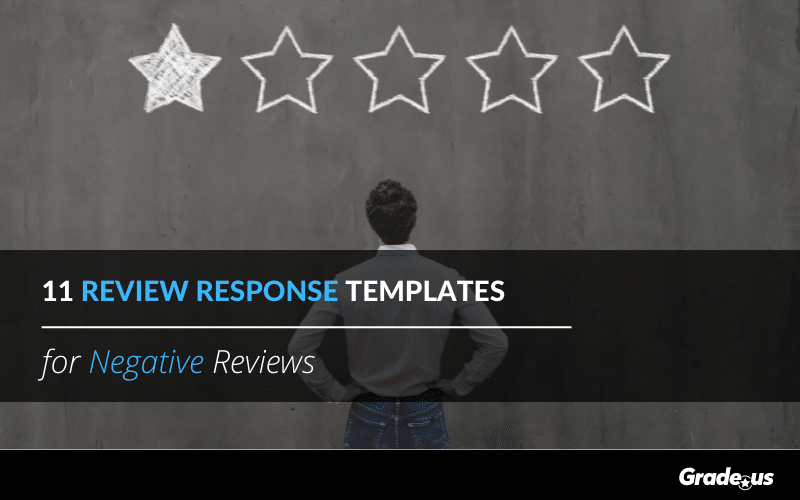Updated 3/24/2022
Most businesses don’t know how to respond to negative reviews.
Negative reviews or Social Media comments, left by unhappy customers, present a serious problem for almost every business. When customers leave a negative review, it’s a sign of broken trust.
It feels like an accusation.
A proclamation stating that your organization failed to deliver as promised. Most people aren’t the greatest at receiving negative feedback. It draws out an immediate strong reaction that can be paralyzing.
Should I respond? If so, what’s the best way?
No matter what, it’s essential for you to know when there’s a negative review about your business published. Review monitoring is going to be the first step in your review management strategy. You can’t fix a problem if you don’t know it exists.
Once you’ve received a timely alert, you need to have your plan of action for responding to negative reviews.
Let’s take a look.
Table of Contents
Why do people write negative reviews?
J.M. Rensink, a researcher at the University of Twente, discovered seven motivations behind positive and negative word-of-mouth. Today, we’ll focus on the negative.
Namely, why customers leave negative reviews.
- Vengeance. This customer has had a bad experience. They feel you’ve wronged them in some way, and they’re out for revenge.
- Anger/anxiety reduction. This customer is trying to self soothe. They’re looking for a way to vent, to purge, relieve, or reduce the pressure from their negative emotions.
- Solution seeking. These customers have a problem but feel they can’t trust their company to fix that problem. They reach out to reviewers and prospective buyers for advice, multiplying your problem.
- Altruism/teaching. These customers are simply reporting the facts as they see them. They’re focused on sharing their experiences with the public at large, whether those experiences are positive or negative.
- Message intrigue. These reviews can be positive or negative. They’re triggered by external activity (e.g., ads, commercials, or a public relations disaster).
These details inform and educate.
Prospective buyers use these negative reviews as profiling tools. They’re resources buyers can use to evaluate your business quickly. With that in mind, let’s take a look at the steps you can take to craft the perfect response.
Why should businesses respond to negative reviews?
The data is clear.
Customers expect you to respond to their reviews, whether that review is positive or negative.
- 86% of consumers who complain expect a response within 3 days.
- Businesses that don’t respond to reviews earn 9% less revenue than average.
- Businesses that respond at least 25% of the time earn 35% more revenue.
- A 30% response rate is the minimum needed to surpass your competitors.
- When enterprises increased their reply rate on Google reviews, they saw an 80% conversion rate increase over their local competitors.
This makes sense though, right?
Who wants to be ghosted when they reach out to a company or vendor for help? This isn’t rocket science. That said, 75% of businesses don’t respond to any of their customer’s reviews.
This is an opportunity.
It’s a chance for you to boost your business’ conversion rates, revenues, and customer goodwill. Responding to customers when they’re unhappy with your company, product, or service shows prospective customers how they’ll be treated if they decide to work with your business.
But it all starts with customer service.
Outstanding customer service, great customer experiences — this is the foundation of great reviews. If you show customers that you’re focused on their needs, you’ll have what you need to produce amazing reviews.
What does this mean? Your support team…
- Provides psychological safety: Your customers believe it’s safe to come to you with any problem at any time. They’re not afraid or worried about the abuse they’ll receive.
- Listens to your customers: It doesn’t matter if they’re happy or unhappy, complaining or validating. Great companies are attentive, empathetic, and focused on their customer’s needs.
- Confirms that they understand: This is repeating customer concerns back to them in your own words, so they’re aware that you understand their complaints.
- Is knowledgeable and prepared: Your support team should be well-versed with the particulars of your customer’s complaints. This means they have answers and solutions to customer complaints, or they know how to get the answers and solutions customers need.
- Anticipates your customer’s needs: Great support teams anticipate their customer’s wants, needs, problems, fears, frustrations ahead of time. They provide customers with a solution to address the challenges customers face.
- Owns and apologizes for company mistakes: Teach your support team how to apologize. Provide them with the scripts and templates they can reference in their responses to customers (see below for examples of both). Show them how to avoid taking customer feedback personally.
- Gives more than you receive: Customer service reps perform best when they have the freedom needed to over-deliver for your customers. They remind their support team that creating value, maintaining, and restoring relationships are the important pieces.
These details are crucial.
But they’re also not common with customer support teams. Many organizations focus their attention on getting customers off the phone. They prefer to do the minimum amount of work needed to get what they want from customers.
This is destructive.
Customers know when they’re being handled or managed. Instead, they’re looking for support reps who are willing to invest the company resources needed to solve their problems.
How to respond to negative reviews
- Personalize the response with the reviewer’s name when possible. Some review sites require a name, and others allow pseudonyms. This is an indicator. It shows the reviewer (and lurkers) that you’re speaking to them directly. You’re not copying and pasting a script or posting a generic reply.
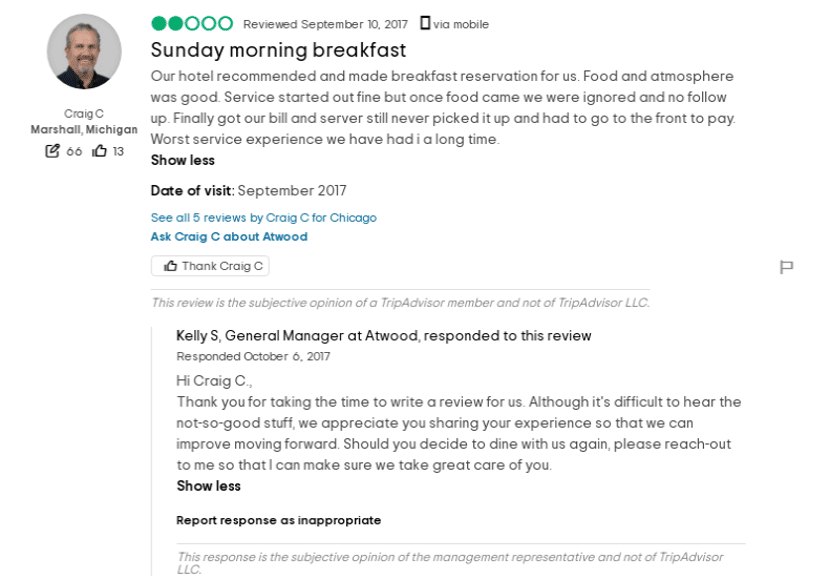
- Thank the reviewer for taking the time to leave the review. Why thank them for a negative review? It establishes psychological safety with reviewers and lurkers; it communicates gratitude for their willingness to share valuable information.
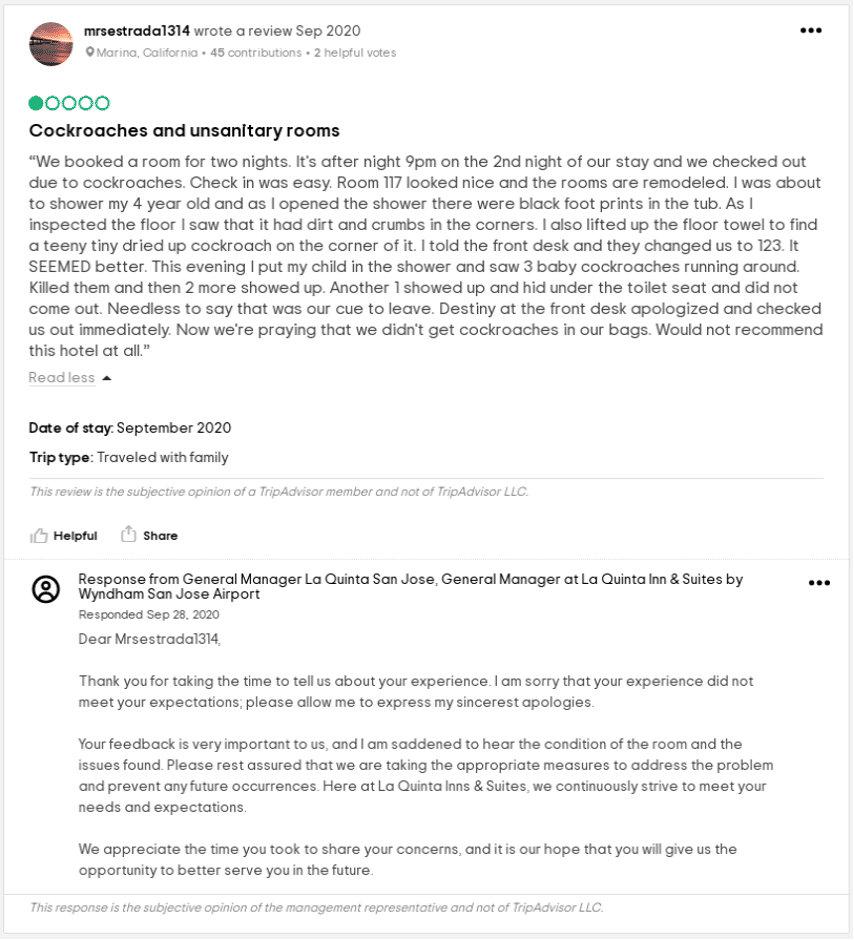
- Acknowledge their problem. It doesn’t matter whether you agree with their perspective or not. They want you to address the reason that they’re writing the review. This is part of showing that you understand. When used appropriately, this acknowledgment places both of you on the same side, attacking the problem together. You can acknowledge your customer’s problem in a variety of ways.
- Rephrase the problem in your own words.
- Empathize and comment on the consequences of the problem. "Yikes, I'd be pretty upset if I were in your shoes."
- Use fear, felt, found. "I ran into the same. Exact. Problem. I was so frustrated; it was like they didn't even care. I don't want you to feel that way; here's what we can do for you..."
- Rephrase portions of the problem, then ask for clarification. "So he canceled your account? When did THAT happen?!
- Emphasize the severity of the problem. "You were billed 2x more than you should have been?! That's definitely not okay. Let's get that taken care of right away."
- Apologize and show empathy: Apologize to them, validate their feelings. This doesn’t necessarily mean that you’re going to give them what they’re asking for. At the very least, show them that you understand and that you’re sorry. Customers are looking for you to apologize, to take ownership of the perceived mistake. How you do it is dictated by the words used in your customer’s review.
- Saying I'm sorry.
- Admitting "we were wrong."
- Asking: What can we do to make this right?
- Promising: We've changed xyz, so abc never happens again.
- What can we do to earn your forgiveness?
Your apology language ensures customers feel understood (I cover this in more detail below). Customers often provide important clues about the kind of apology they’re looking for. What’s galling about the usual apologies customers receive is the fact that they aren’t apologies.
Take a look.
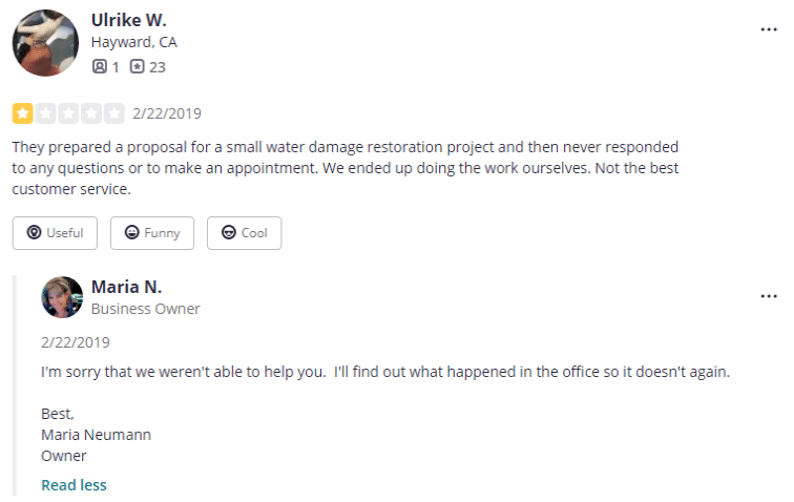
- Try to provide a solution when possible. Make things right. This might mean taking responsibility for a misunderstanding or compensating them if they were wronged. It’s important to present customers with solutions to their problems, even if the problem is their fault.
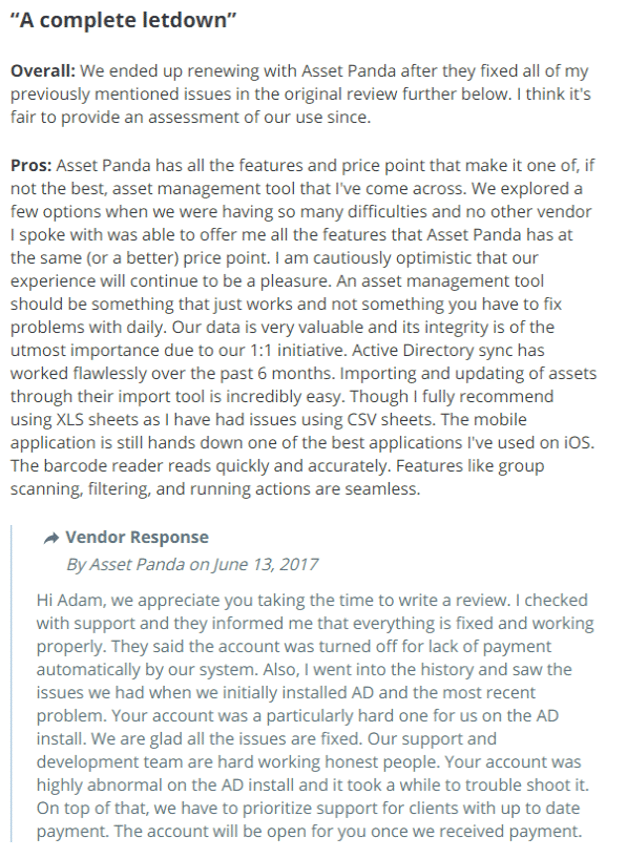
- Take the conversation to a non-public channel. Provide the reviewer with a personal or support email and ensure that they’re able to get the help that they need. Generally speaking, this is a good idea. Some customers believe businesses are eager to take the conversation offline to avoid shame or bad press. To a certain extent, they’re correct. But there are far more important reasons to take the conversation offline.
- Avoid disclosing private information (e.g., personal, financial, etc.)
- Minimize non-compliance hazards
- Avoid humiliating or embarrassing the customer
- Minimize the exposure of sensitive corporate information (which may hurt your company)
- Avoiding legal hazards or liability concerns
This isn’t a comprehensive list.
An initial response to customers is fine, but review responses aren’t supposed to be extended conversations where there’s a significant amount of back and forth. Customers are also very unlikely to get into a long, drawn-out conversation (unless they’re worked up emotionally).
A brief response followed by an invitation to message you for additional help is appropriate (e.g., would you send me an email at [email protected] or call me direct at 708-123-4567? I’d like to address your concerns personally). Here’s an example of that in action.
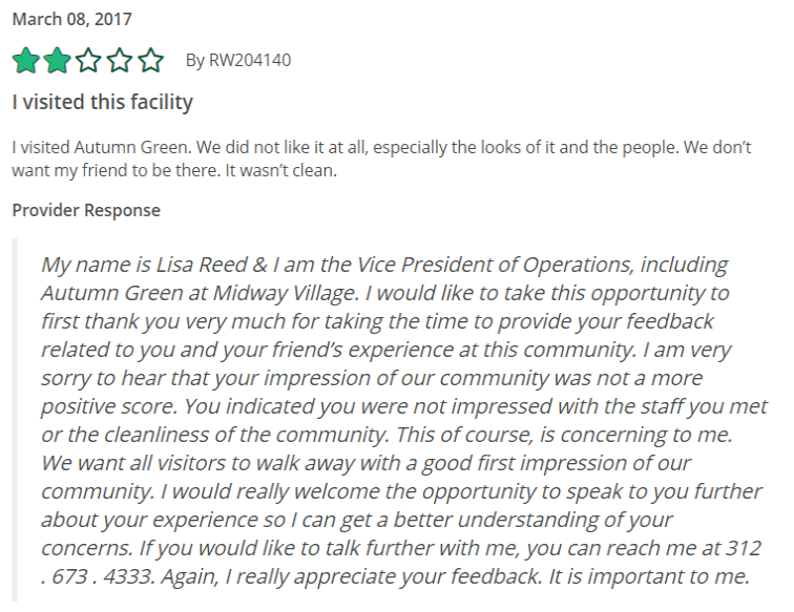
With this framework, let’s take a look at how we can use our templates, personalize them, and apply them to each type of negative feedback.
Review response template #1: The vengeful customer
This customer isn’t looking for satisfaction; they don’t want a resolution to the problem. Their focus is uncomplicated. They want to hurt you. The more damage they’re able to produce, the better.
Here’s an example:
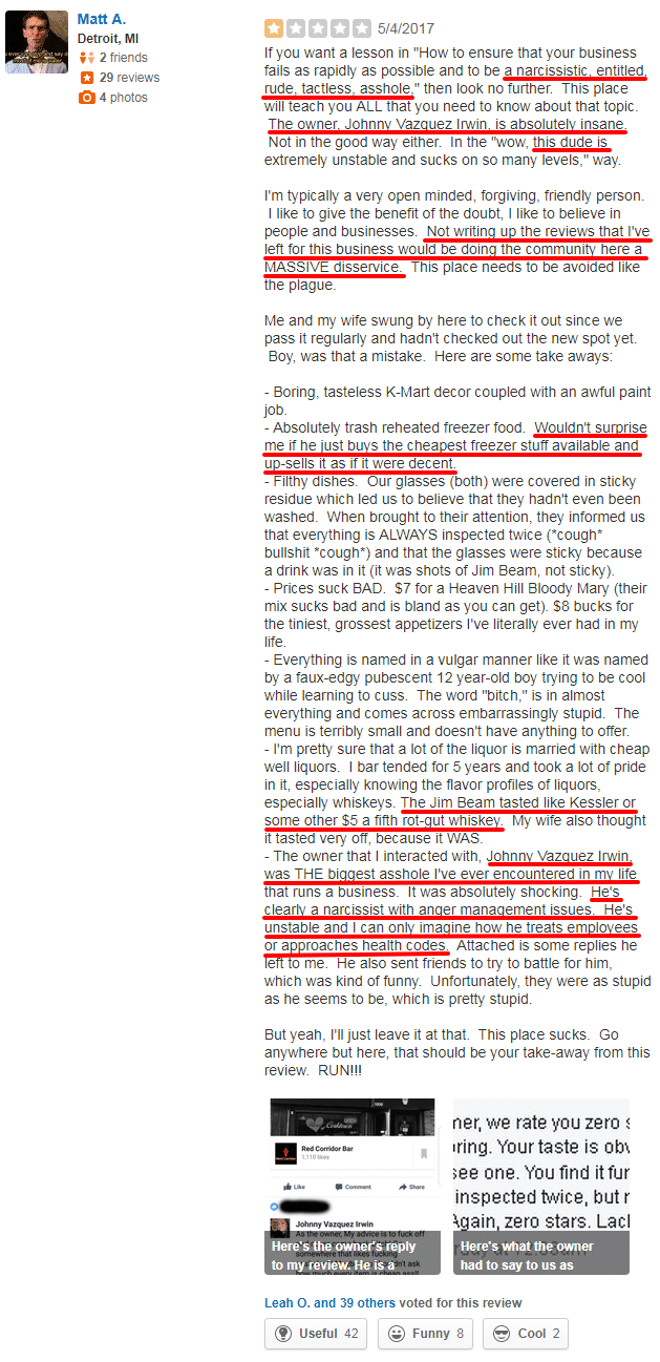
This customer hates their business. Not only are they willing to post a negative review, they’re attempting to rally reviewers to their cause. They reported this business to the Attorney General’s Office, and they’d like every customer to do the same.
They want to see this business fail.
How should you respond to a customer’s review when you’ve let them down? Is there anything you can say to restore or salvage the relationship?
Here’s a template you can use to respond to your vengeful customers.
Hi [Reviewers Name],
[Name] here, I’m the [title] at [business name].
I’m so sorry we let you down.
We’ve taken your feedback and the feedback of other reviewers to heart. We’re in the process of making some major changes.
[Specific yet concise list of changes]
Is there anything we can do to make this up to you? I completely understand if you’re angry and simply looking for space/closure. However, I’d like to make things right if I can.
Are you open to this?
[Manager name | contact number]
Why it works:
It’s easy to attack a faceless corporation. It’s not quite as easy to attack a specific person, especially one who is innocent and simply attempting to do their job. Beginning and ending with a name improve your odds of humanizing the conversation.
It’s no guarantee of course.
In fact, if you’re dealing with a vengeful customer, the chance of this working is very low percentage.
This is good news.
This response isn’t for your vengeful customer. This response is for future prospective buyers who stumble across your negative review. As a whole, customers are reasonable people. They expect to see negative reviews. But more importantly, they’re interested in seeing how you respond to these negative reviews.
That’s the key.
Review response template #2: The angry/anxious customer
These customers are angry.
Their anger may be based on several legitimate or illegitimate factors concerning your situation. Here’s the key differentiator. At first glance, these customers sound like the vengeful customers we’ve just discussed.
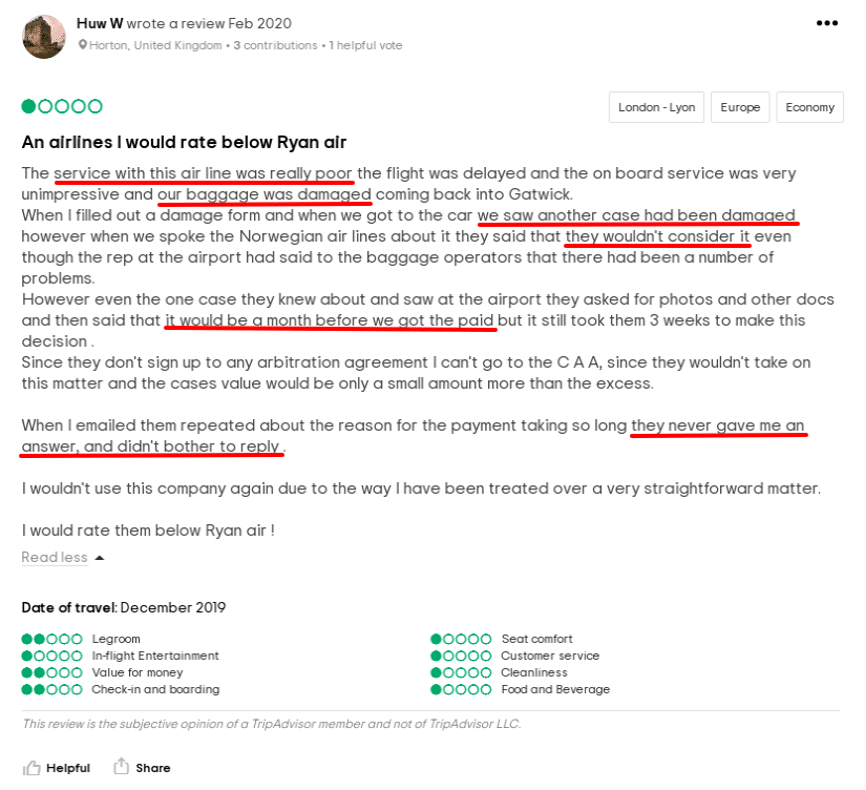
This customer has a right to be angry, don’t you think? He had certain expectations going in. He paid for his flight with the expectation that he and his luggage would arrive safely. He arrived safely, but his luggage was badly damaged. The obvious move here would be for the airline to replace their luggage and any missing or damaged contents (plus something extra for their troubles); it may seem like an over the top response, but that’s what’s needed here.
This is salvageable.
This business didn’t make the right choice, but mishaps like these can be repaired. But only if you’re able to show that you care about your customer’s problem.
Okay…
Here’s a template you can use to respond to your angry customers.
[Reviewers Name], you’re right.
You expected [result], you should have received that, but that’s not what we delivered. If I were in your situation, I’d be pretty upset too.
I’m so sorry we missed the mark on this.
We should have caught this the first time, but we didn’t. These mistakes have been hard (and expensive) lessons to learn. We’re using your feedback to [concise list of changes].
Can we make this up to you (at our expense)?
I’d like to do whatever I can to correct our mistake and earn your forgiveness. What can we do to make this right?
Please reach me directly at:
[Manager name | contact number]
Here’s another template you can use for this type of customer.
Dear [Reviewers Name],
What you went through — it all sounds horrible. I’m so, very sorry. This should not have happened. You expected [result], but that is not what we delivered.
Can we make this up to you (at our expense)? Please contact me directly at [your phone number] or [[email protected]]. I’d like to get this resolved for you within 24 hours if you’re available.
Your experience with us was terrible. You deserve better; please allow us to show you.
[Manager name | contact number]
- Regret. These customers want to hear the words “I’m sorry.” They want to see and understand that you feel regret for your actions.
- Ownership. These customers want you to accept responsibility for your mistakes and own them – without excuses, evasion or blame.
- Restitution. These customers want you to restore them, to make things whole. This could be issuing a refund, doing the work for free, replacing a particular item.
- Reform. These customers want to know what you’ll do to prevent this issue or problem from ever happening again.
- Forgiveness. These customers want you to request reconciliation. They want to see your humility and/or vulnerability. Some may intentionally reject you when you ask. Others may welcome you back with open arms.
Review response template #3: The solution seeker
Customers aren’t always emotional. Some customers just want a solution to a specific problem but they’re too afraid to ask for help.
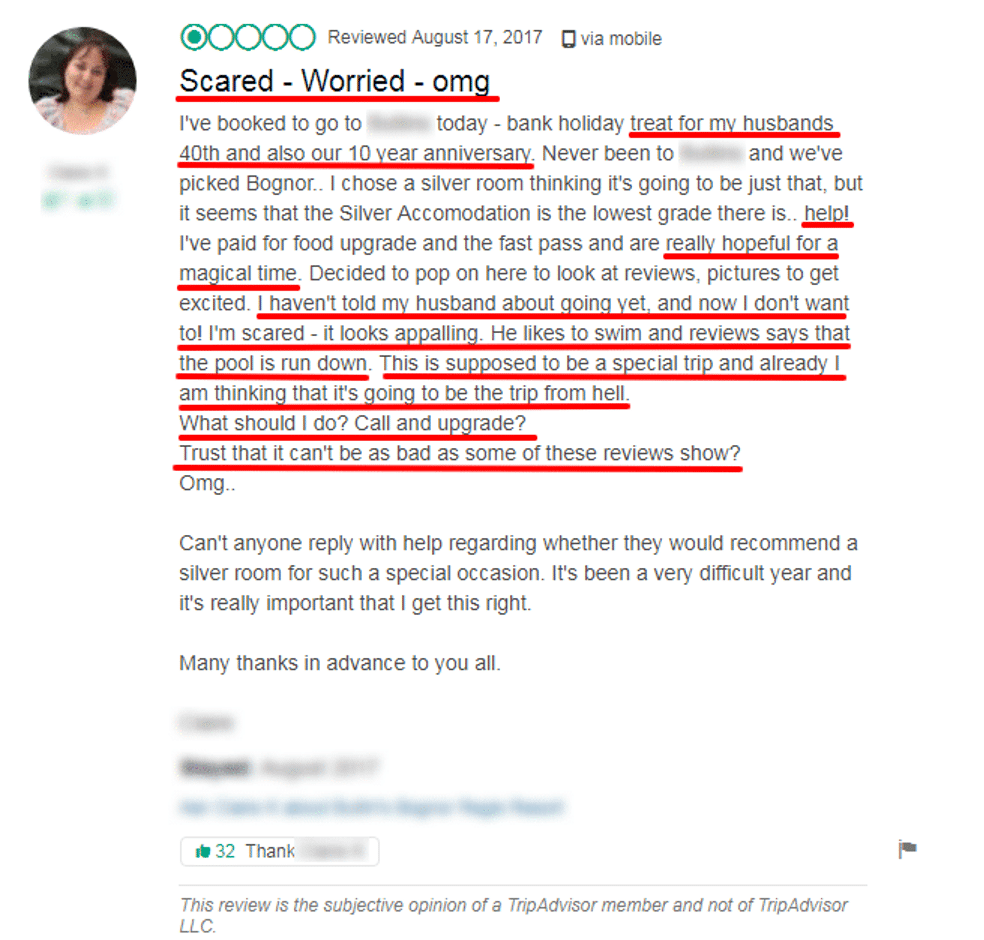
These relationships can be repaired if you’re willing to: (a.) Go above and beyond for your customers (e.g. making yourself fully available to customers) and/or (b.) Reversing the risks they face with a promise of some kind (e.g guarantee, warranty, or seller-assumed risk).
Here’s a template you can use to respond to your solution seeking customers.
[Reviewers Name], thanks for reaching out.
Your concerns make sense. We could have [taken particular actions] to relieve your stress and anxiety but we didn’t do that. I’m sorry about that.
Here’s what I can do for you.
I can [concise list of solutions/action steps].
As a courtesy, I’d also like to offer a complementary [bonus actions/reward/incentive]. Would this help to make things right?
Please let me know,
[Manager name | contact number]
Here’s another template you can use.
[Reviewers Name],
Your concerns make sense.
I’m sorry we weren’t as [clear] or as [attentive] as we should have been. You shouldn’t have to deal with these issues on your own. Would any of these options work for you?
[concise list of solutions/action steps].
Would any of these help to make things right? Please contact me directly at [your phone number] or [[email protected]], and I’ll take care of this personally for you.
[Manager name | contact number]
Why these templates work:
This gives solution seeking customers a way to solve their problem. If you’ve missed the mark somewhere along the line, now’s the time to apologize. Just be sure to use the appropriate apology language. You’ll need something else to seal the deal.
A bonus, reward, or incentive.
Your goal here is twofold: (1.) Reduce the risks to customers searching for a particular problem and (2.) Take those risks onto yourself.
Review response template #4: Altruism/teaching customers
These customers are simply about reporting the facts as they see them. Their experience can be positive, negative, or neutral — this isn’t their focus. Their focus is on helping others – prospective buyers who are interested in an unbiased account of their experience with you.
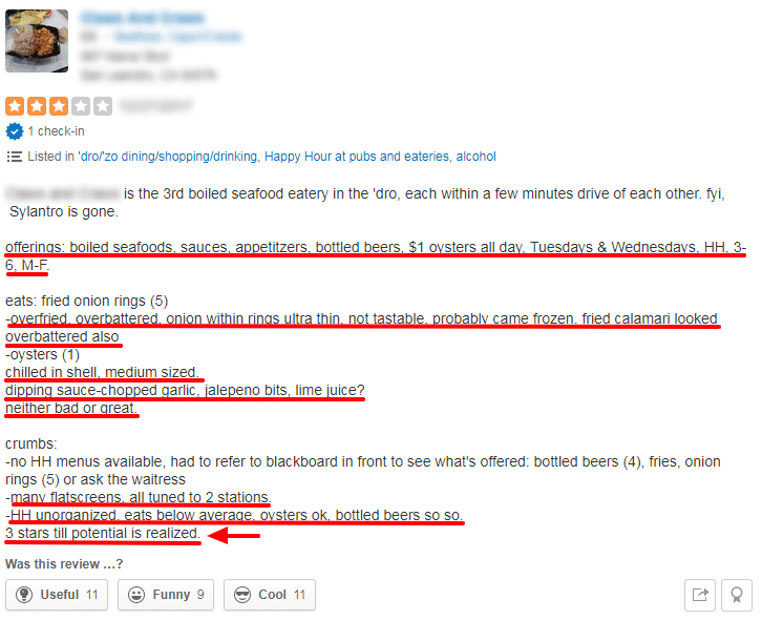
Responding to a negative review from an altruistic/teaching customer is straightforward.
Just the facts.
They’re going to share the facts and details of their situation: their experience, the events in question, and specific information. That’s what your response needs to include.
How do you do that?
Here’s the template you can use to respond to your altruistic/teaching customers.
Hi [Reviewers Name],
I wanted to thank you for sharing your thoughts and feedback with us. I’m disappointed to hear that you were treated in a way that was less than you deserve.
I’m so sorry about that.
This shouldn’t have happened to you. We dropped the ball completely here. If you’re open to it, I’d like to make this up to you.
Please let me know,
[Manager name | contact number]
Here’s another template you can use:
Dear [Reviewers Name],
Thank you for taking the time to share your feedback. You’ve given us some valuable information and shown us where we need to improve.
You deserve better than this.
I’m sorry, this shouldn’t have happened at all. Would you give us a chance to make this right? I’d like to take care of your issues personally and make sure your problems are resolved. If you’re interested, please contact me directly at [your phone number] or [[email protected]].
Thanks to you, we’ve made the following changes:
[Concise list of changes]
I’ll make sure this doesn’t happen again.
[Manager name | contact number]
Why these templates work:
This response is light on emotional language. Remember, these altruistic/teaching customers are typically focused on the facts. They’re interested in giving those around them a truthful, fair yet unbiased account of their experience with you.
Which just so happened to be negative.
Go above and beyond for these customers. Do whatever it takes to woo them back to your corner. Take care of them. Shield them from the issues that created these negative reviews in the first place.
Take care of them.
Do it without an expectation of return, even if it means they still reject you. Do it for your future buyers; respond even if you’re unsure about the outcomes or potential profit.
Review response template #5: Customer blackmail
Some customers aren’t fair.
They’re willing to use blackmail to get what they want from companies. A recent post in CNET found that hotels and restaurants are noticing an increase in blackmail threats.
But why?
“Instead, they apparently suggest that unless the establishment doesn’t treat them in an exaggeratedly accommodating way, they’ll post a negative review to a site like TripAdvisor. They allegedly demand upgrades in hotels, or free meals in restaurants.”
Yikes.
Here’s an example of that:

Here are some strategies and templates you can use to deal with customer blackmailers.
If you’re a B2C organization, make sure you have surveillance cameras with audio.
Save all written communication as evidence.
Report any demands or claims to the police immediately. You can use it as evidence to exonerate your business, even if the blackmailer isn’t caught.
Consistently request reviews from customers; this will make it more difficult for blackmailers and spammers to attach themselves to your business.
Simply having evidence you can use or reference in your reviews provides you with the tools and resources you need to counteract any claims against you.
Here’s a response template you can use to address their accusations.
This customer is attempting to blackmail our business.
They contacted us on [date] and demanded an upgrade to their hotel room. On the call, they implied that they would post a negative review if we didn’t fix the problem.
Only there was no problem.
Here’s a screenshot of their email and the audio from their phone call.
[Manager name | contact number]
Here’s another template you can use:
This customer is attempting to blackmail our business.
We’ve reported them to [review site], and we’re waiting on their reply.
They contacted us on [date] demanding that we:
[list blackmail request here].
They told us they’d post a negative review on all of our review profiles if we didn’t comply. We don’t believe this is appropriate and have taken the proper steps to address this fraudulent review.
[Manager name | contact number]
Why these templates work:
If you can provide future prospects with the evidence they need, most customers are more than willing to take your word for it (provided that your claim is a compelling one).
You must be morally appropriate.
That means no name-calling, personal attacks, raging, condescension, or manipulation. Tell the kind truth, even though your blackmailer doesn’t deserve it. This gives you the moral high ground, and it shows everyone you’re willing to do what’s right.
It’s important to note here that your first step should be flagging and reporting the offending review to the site owners in question. If you’re absolutely convinced that this review is fraudulent, it’s a good idea to pursue this option first. That said, this option may be hit or miss depending on the platform.
Review response template #6: Review spammers
- Were written by a bona fide customer who has used your product or service.
- Represented the facts of the transaction from a reasonable but subjective point of view.
- Follow the terms and conditions of the review platform the review is posted on.
- A competitor who’s looking to bury your business under an avalanche of negative reviews or accumulate positive reviews for themselves.
- A legitimate customer who had a transaction but decided to lie about it for their own personal gain.
- An illegitimate customer who never had a transaction with you but decided to lie about it.
- An incentivized reviewer who is compensated or rewarded in some way to write a review that’s for or against your business.
- The reviewer violates any review platform guidelines (e.g., discriminatory, hateful or libelous content).
Here’s an example.
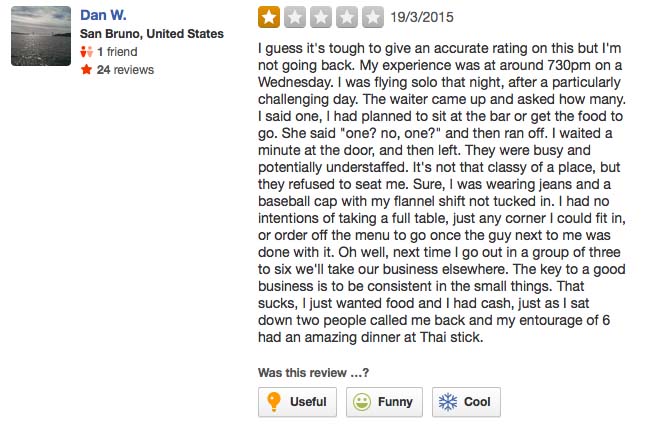
A Yelp reviewer named Dan. W, posted a one-star review of Wonderful, claiming staff refused to seat him as he was alone. He mentioned waiting around for a table and then leaving.
Here’s the problem.
Dan lied about his encounter with the staff at Wonderful. He was in the restaurant for 22 seconds and decided against speaking to anyone. Restaurant owners had him on camera.
There’s no question about it. This customer was dishonest.
Here’s a response template/framework you can use to deal with spammers.
We don’t have any clients with the name [Client Business]. And we don’t serve any clients in the [mentioned] industry. We’ve only ever focused on clients in the [your industry] industry.
- Flag/report the review
- Take applicable steps to follow up
- Repeat as necessary
[Reviewers Name], thank you for your feedback.
Depending on the review, this may also be an appropriate time to say nothing. If it’s blatantly obvious and unreasonable, it may be a good idea to say nothing and continue to monitor the review. Customers are sophisticated enough to discount these reviews.
Why these templates work:
These reviews are factual. They’re focused on the events that happened in the truth behind the reviewer’s claims. There’s no defensiveness, no name-calling, condescension, anger, or contempt.
Just cold hard facts.
This levelheaded approach is far more believable to customers than one that’s overly defensive or difficult.
Unique Review Attacks #7: The angry mob
Ayesha Curry, wife of Golden State Warriors point guard Stephen Curry, decided to open a new BBQ restaurant. In Houston.
The problem?
The Golden State Warriors defeated the Houston Rockets in the NBA semi-finals. Fans responded by flooding his wife’s restaurant with fake one-star reviews before it even opened.
Ayesha Curry’s restaurant is coming to Houston, and #Rockets fans have already piled up the 1-Star reviews before it even opened 😂😂😂 #Warriors #NBA pic.twitter.com/3BqL84zlJy
— Tomer Azarly (@TomerAzarly) June 19, 2018
How do you handle an angry mob?
Fortunately, Yelp has put measures into place to protect your business.
For other sites like Facebook, you can temporarily hide your Recommendations tab while you resolve the issue and reach out to Facebook support. You should always try to get the fake, trolling, or rule-breaking reviews flagged and removed.
Sometimes Facebook is not very responsive to Recommendation removal. In that case, you’ll need to use traditional marketing channels (advertising, guest posts, interviews, publicity, etc.) to counteract the negative reviews and hate trolling.
Review response template #8: The non-customer review
The non-customer review is a variant of the spammer.
This reviewer could be a competitor, a spammer, cybercriminal, or disgruntled ex-customer. They could be motivated by revenge, profit, or control.
Here’s an example.
Mark Jackson, founder of Vizion Interactive, wrote a scathing post about a review platform. That post led to Google taking action against the review platform. The owners of that review platform retaliated against his company posting negative non-customer reviews on Yelp and other platforms.
Take a look.
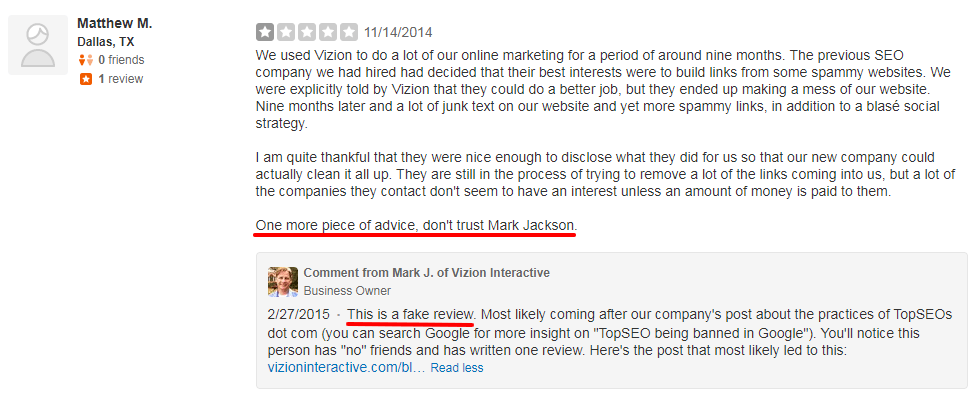
So how do you handle these reviewers? You call them out with facts and you share evidence. Here’s a response template you can use to do that.
This review is fake.
We don’t have any clients with the name [Client Business]. And we don’t serve any clients in the [industry]. We’ve only ever focused on clients in the [your] industry.
Here’s another template:
This review is fake news.
We’ve received threatening emails from a competitor who is looking to punish us for a post we wrote exposing unethical behavior at their company. Here’s a screenshot: [link].
We’ve never worked with anyone by the name of “[Reviewer name]”
And another you can use.
This review is misleading.
It’s incorrect for the following reasons.
- [Concise list of reasons]
We’ve requested that [review site] remove this fraudulent review.
[Manager name | contact number]
Why these templates work:
It’s a factual account that’s combined with a story. It gives readers (and prospects) a compelling reason to believe you instead of your negative reviewer. It also (ideally) gives them facts and evidence to hang their belief on.
What about COVID-related negative reviews
Take a look at this review.
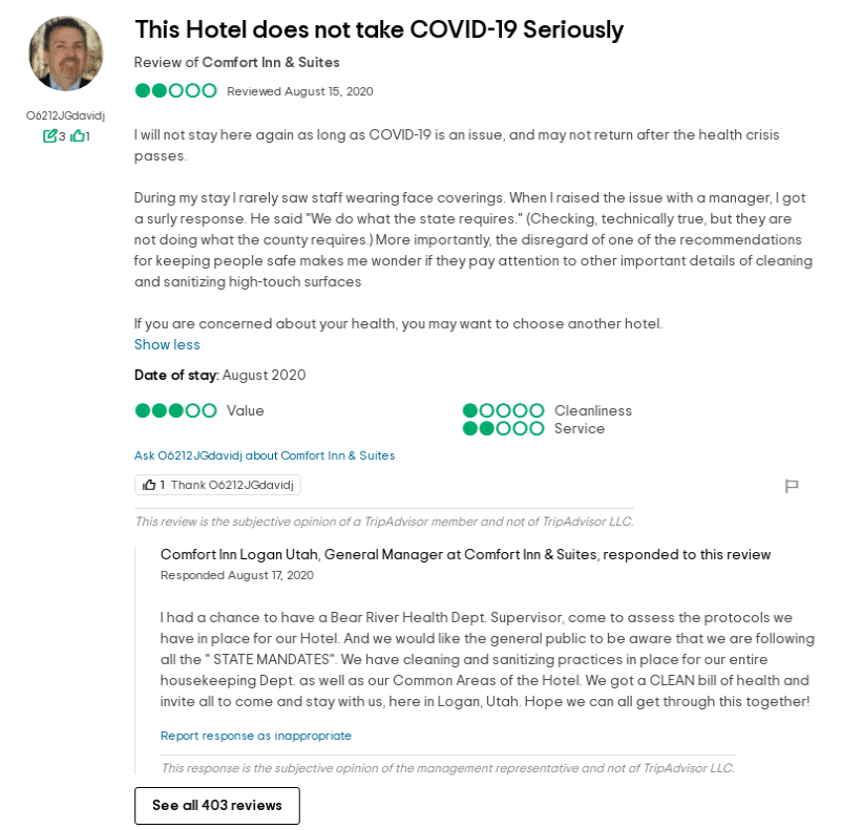
This was during the middle of the pandemic.
This review is a disaster, especially as most hotels are struggling to return to business as usual. The customer offered a valid concern. Hotel staff decided against wearing their masks, it wasn’t an isolated incident, it simply wasn’t mandated by management.
How did the hotel respond?
They argued with the customer. They became defensive, telling customers that they’re following state mandates (in all caps). But that isn’t the problem here.
It’s comforting customers.
If you’d like customers of all stripes to do business with you, there needs to be some wiggle room on the rules that you choose to follow. Some customers may feel comfortable without masks, others feel it’s an important requirement that’s necessary for the safety and well-being of everyone in the building.
If you’d like to keep your business going, you may need to find a way to accommodate everyone. Or find a way to segment customers who aren’t a fit for your values and norms (which may be catastrophic for your business).
How should you respond?
Assuming that you’d like to maximize the number of customers, you bring in to your business?
Well, it’s a good idea to:
- Consistently reaffirm your stance on hygiene, safety, and policy
- Outline how your employees follow these policies
- Apologize for lapses or failure points when reviewers point them out
- Make any lapse in judgment right with customers
- Consistently update customers on the changing mandates and requirements via social media and email
- Provide customers with a way to opt-out of any required mandates (e.g., delivery, online orders, curbside assistance, etc.).
If you’d like to keep customers on the same page, you may need to take a more prudent approach with all of your customers.
What if you can't say 'sorry'?
Ah yes, the elephant in the room.
There are instances where you can’t or shouldn’t say sorry because it forces you to deal with the legalities of that decision in other ways. What does this mean in the context of online reviews?
It means there are legal consequences for saying “sorry.”
Peter Rehm and Denise Beatty, in their search report, “The Legal Consequences of Apologizing” outline the benefits of apologizing.
“It is difficult for the injuring person to maintain self-respect in the presence of those who were injured. An apology can reestablish this self-respect. The failure to apologize, or inability to apologize successfully can lead to strained relationships, grudges and vengeance.
Something magical happens, however, when we apologize to those we have hurt. A sincere apology, tendered and accepted, can heal humiliation and generate forgiveness. The sincere apology includes: (1.) acceptance of responsibility for wrong-doing; (2.) an explanation for the offense; (3.) communication that the offensive behavior was not intended as a personal affront; and (4.) the expression of genuine, soul-searching regret, communicating guilt, anxiety, and shame.”
At this point, your attorneys or in-house legal teams are pulling their hair out. ‘You can’t say sorry, it’s an admission of guilt that establishes a claim!’
If you admit guilt, it’s an admission of wrongdoing and any lawsuit against you is an automatic slam dunk.
That’s the fear, right?
Well, their report looks at several worst case scenarios.
Medical malpractice claims.
They looked at several cases where doctors admitted to making serious mistakes while caring for their patients.
What did they find?
- Apology for a serious mistake during surgery did not establish any element of a malpractice claim.
“Plaintiffs, supposedly armed with an apology, must prove their cases just as if the apology did not exist. A mere apology does not prove any of the elements of the case because evidence about particular medical facts or events is still missing from the plaintiff’s case. Since a mere apology pertains to a doctor’s self-image and feelings, it is not evidence of any particular medical fact or event. This leaves the plaintiff legally in the same position as one who did not receive an apology.” – emphasis added.
If a customer wants to sue you, you’re in the same boat legally, whether you apologize or not.
2. Apology for the inadequate outcome of a medical procedure was not an admission of liability.
“It appears safe for a practitioner to apologize for an inadequate outcome or result, as long as there is no admission that the inadequate outcome was caused by the practioner’s negligence. It appears that there is an understanding that the result of an operation is not guaranteed, not every operation will be successful, and an apology for the inadequacy of an operation does not mean the doctor is liable for negligence.”
This obviously isn’t enough to convince legal.
But what if Rehm and Beatty are right? What if an apology is the right thing to do and it helps you avoid litigation? It seems like an apology isn’t enough for a plaintiff to win their case.
What if legal still says No?
Is there a way for you to restore the relationship with unhappy customers without admitting fault or negligence? What can be done to show customers that you truly care about their concerns?
Here are a few ideas.
Review response template #9: Empathize, promise to investigate, then report back with a solution
Here’s a template you can use to do just that.
Hi [Reviewers Name],
This is rough. It’s really upsetting to hear that you had this kind of experience. Would you be willing to contact me directly to share the specifics of your situation? If what you’re saying is accurate, heads will roll.
Please let us make this right for you.
[Manager name | contact number]
Why this template works
This template puts you and the customer on the same team. It unites the both of you against the problem instead of the usual us vs. them dynamic. The best part about this is, it isn’t an admission of guilt or negligence. Your customers see that you’re alarmed and your willingness to hold your team accountable shines through.
The delivery takes nuance but when it works, it’s a fantastic way to restore the relationship.
A word of caution.
Use this approach sparingly. It tends to turn your customers into tattletales when it’s overused. This creates an adversarial relationship between your employees and your customers.
That’s no good.
Use it well but make it clear that you’re on the side of what’s right whether that’s for or against your customer.
Review response template #10-11: Fix the obvious, investigate the nuanced.
Here’s a template you can use to do that:
[Reviewers Name],
If you were promised [offer] but you received [negative outcome], that’s not okay. Please reach out to me and I’ll take care of this personally. As far as the other [negative outcome] you’ve experienced, can you give me more details?
I want to make sure I address these issues for you so you don’t have to deal with this again.
Please let us make this right for you.
[Manager name | contact number]
Here’s another template you can use:
[Reviewers Name],
My name is [First, Last Name], I’m the [title] at [company].
My stomach hit the floor when I read your review. This is not the kind of experience you should have with our [business]. Would you allow me to take care of this personally for you? If what you’re telling me is true, what you’ve experienced is an absolute disaster.
Please contact me so we can fix this for you.
[Manager name | contact number]
Why these templates work
This template provides customers with quick wins — this is precisely the kind of thing you need to restore trust. If there are legitimate complaints, you can fix them without an admission of guilt or negligence. Fix all of the little issues first and provide customers with updates for each.
Do this while you’re investigating and working on the bigger issues at play.
Restoring the relationship doesn’t have to put you in legal hot water. I realize that every industry is different (or that attorneys believe that) so you’ll want to make sure you’re working with your team on this.
If they’re not convinced apologies are okay, go with it.
Find ways to restore the relationship and avoid going against their recommendations.
How do you respond to negative reviews?
Negative reviews present an opportunity, and most of the time, customers just want their problem solved or want your empathy when they’ve felt slighted.
If you ignore their negative review, you’re presenting yourself as an organization that doesn’t care about your customers.
If you don’t know that you’re receiving a negative review, that responsibility falls on you.
Prospective buyers use these negative reviews as profiling tools. Straightforward tools they use to evaluate your business. I’m not pretending that negative reviews are good for your business. They’re not positive reviews (which you should also respond to). But they aren’t a fatal blow either.
Aside from taking the time to work with your unhappy customers (and sometimes getting them to change a bad review), when you generate positive reviews, you can offset the damage. Asking for and earning positive reviews with email review requests or text messages can provide a bit of a moat from the one-off unhappy customers.
As you address the negative feedback that’s impacted your company, plan on customizing these negative review response templates. If your response comes off as purely templated, your angry and upset customers will see that. So will other customers that are thinking about buying from you.
You’ll have the tools you need to respond to a negative review appropriately.

